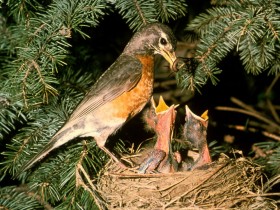 On Mother’s Day weekend, many of the wild creatures at Crossroads at Big Creek are becoming mothers. For fish, frogs and insects, motherhood does not extend beyond laying eggs, but for birds and mammals, motherhood is a genuine commitment. Mother birds, for example, are instinctively compelled to care for their young, even before the eggs hatch.
On Mother’s Day weekend, many of the wild creatures at Crossroads at Big Creek are becoming mothers. For fish, frogs and insects, motherhood does not extend beyond laying eggs, but for birds and mammals, motherhood is a genuine commitment. Mother birds, for example, are instinctively compelled to care for their young, even before the eggs hatch.
During our annual EGGstravaganza, one of the children asked, “When a mother bird lays an egg, how long will it be before it hatches?” As in most nature questions, the answer begins with “It depends.”
Some baby birds such as chicks and ducklings are fully developed when they hatch. Within hours after emerging from their eggshells, they are cute and fluffy, and able to see, walk, and feed themselves. These precocial birds require about three or four weeks to develop before hatching.
In contrast, many of our songbirds are blind, naked, and helpless when they hatch. These scrawy pink infants must remain in the nest, cared for by the parents. Almost like premature human babies, these birds are born before they are fully developed. It make sense—and it turns out to be the case—that the birds which are born helpless have a shorter incubation time and smaller eggs.
But unlike human babies, which develop in the mother’s body, bird embryos do their growing in the egg, and for development to take place, an egg must be warm—somewhere in the neighborhood of 104 degrees
If a mother bird lays an egg and does not sit on it, the unborn chick does not start to develop. Does this happen in nature? Absolutely.
During their nesting season, most songbird mothers lay an egg every day or so. For example, it might take four or five days for a robin to lay four eggs. Yet all four baby birds hatch on the same day, usually simultaneously, or at least between minutes of each other. And this is important. It would be next to impossible for a mother bird to keep some eggs warm while trying to feed hungry hatchlings.
So the mother bird does not begin incubating the eggs until she has laid all of the eggs she is going to lay. This is not true of all birds, but apparently many species of birds have a specific number—a “clutch size”–that seems just right. This is more complicated than it sounds, because clutch size varies depending on the age of the mother bird, the time of year, and whether she is working on her first or second brood of the season.
A mother bird just keeps laying eggs.-one a day until she instictively knows that enough is enough. Then, and only then, does she start incubating the clutch. Because of this behavior, all of the eggs are warmed the same length of time, even though they have been laid days apart.
Nesting seems to be late this year, probably due to the cold weather, and spring green up is late too, but on Mother’s Day, there will be flowers at Crossroads. This will be my first Mother’s Day since the death of my mother, and my most cherished memories of her involve tramping through the spring woods searching for wildflowers. We invite families to join us at 3:00 Sunday for a gentle ramble down to the creek and through the woodlands. Moms deserve flowers on Mother’s Day.
If you enjoy searching for wildflowers, you might want to participate in the wildflower inventory of Crossroads. Every few years, we record the locations and blooming dates of the flowers of Crossroads. We hope to establish a long term record of weather and habitat changes. No experience is necessary, though shoes that can get wet are a good idea.
Saturday night, the Door Peninsula Astronomical Society will hold a Viewing Night at our Astronomy Campus. Starting around 8:00 if there are clear skies, members of DPAS will share the wonders of the night sky. Views of Saturn should be spectacular this month. Viewin nights are free and open to the public.

